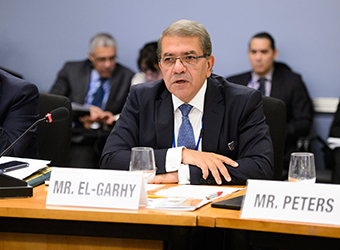For Amr al-Garhy, Egypt’s Minister of Finance, winning over international bond investors meant convincing them that last year’s sharp currency devaluation marked a turning point for the Egyptian economy.
The former investment banker led a lengthy roadshow for a $4bn sale, which took him to Dubai, New York, Los Angeles, Boston and London, to pitch Egypt as a viable addition to investor portfolios.
By the time bankers closed their books on the deal last week, more than 790 bondholder accounts had placed orders of some $13.5bn. The figure suggests that al-Garhy successfully sold the story of a country willing to enact long-resisted reforms and heal an economy that has struggled to attract international money since the 2011 Arab Spring uprising.
Banks advising on the sale said they “have not seen a roadshow this attended in recent years”, el-Garhy told the Financial Times on a visit to London. “Don’t forget Egypt is coming from a period where the fiscal condition on the ground was enormously difficult. Right now we see a very strong level of stability.”
Egypt’s return to debt markets for the first time since 2015 also underscores the resurgent investor appetite for emerging market debt, with Argentina, Turkey, Honduras and Colombia borrowing this year. A rout after the US election, which mauled emerging market equities, bonds and currencies, has given way to opportunism.
So far this year, emerging market governments have raised $27 billion on international markets, just shy of the $28 billion record set over the same period in 2014. Large sales are expected to continue, with Kuwait and Saudi Arabia making plans to borrow tens of billions of dollars.
Egypt plans to come to the markets again by early 2018, possibly with a euro-denominated bond.
The EM recovery has centred on those countries pushing through economic or fiscal reforms, as well as oil exporters, said Edgardo Sternberg, a portfolio manager with Loomis Sayles.
“Whenever there is the belief that interest rates will go much much higher . . . emerging market debt has sold off very hard. One of the reasons it did was that most countries were indebted in hard currency, didn’t have much in terms of reserves, and the debt was much shorter term in nature. We’ve had an easing of that situation. Not all debt is held in dollars, not all debt is short term and foreign reserves are padded in nearly every emerging market.”
For Egypt, which has suffered a dearth of foreign currency since the Arab uprising, the decision to undertake radical reform was driven by an acute deterioration in the economy, which appeared on the brink of crisis last year.
Former military general Abdel Fattah al-Sisi’s government last year imposed a value added tax and slashed subsidies. Most dramatically, it unpegged the Egyptian pound in November, causing the currency to lose half its value and paving the way for a $12 billion loan from the International Monetary Fund (IMF).
The country would further support its economy by privatising state-owned companies, el-Garhy said, contending that by 2020 the country’s ambition is to halve its 12 per cent deficit and cut debt-to-gross domestic product from just under 100 per cent to 75 per cent.
Rajiv Shah at BNP Paribas, which helped to sell the country’s debt, said Egypt’s ability to sell 30-year bonds along with five and 10-year maturities, showed investors were willing to take a long-term bet on the country’s future. Egypt paid 8.5 per cent to issue the 30-year bond. By contrast, Argentina sold a 30-year bond at 8 per cent.
“Investors have cash to invest. Rates are relatively stable for the near term but the ability to lock in this kind of yield was pretty attractive. You saw some of the same things with Argentina as well. In the 30-year part of the curve, investors were willing to bet on the credit improvements in Egypt.”
However, Egypt, which is rated subinvestment grade by Moody’s, still faces significant headwinds. Tourism has evaporated, millions of people live below the poverty line and youth unemployment is high. There is also discontent at limitations on freedom of expression.
In wider emerging markets, the US dollar’s rapid gains and higher Treasury yields have increased the cost of borrowing, although banks say prices for bonds issued by developing countries have been resilient so far.
“We are neutral on emerging market external debt,” said credit strategists at Bank of America Merrill Lynch. “We expect global rates to rise this year and uncertainty to increase under the Trump administration. But technicals remain supportive . . . as US and European rates remain at historical lows, driving global structural demand for duration as investors seek higher yields.”
While the going is good, governments in developing countries are likely to accelerate their debt sale plans, said Mr Shah.
“If they had a plan to issue this year they might as well be looking to issue now,” he said. “It will be on their minds that, whilst there is a stable rate environment, investors with cash are going to be looking at the market today.”
Source: Financial Times
